There’s a new sense of excitement and anticipation for Portugal as they enter the Euros.
After Roberto Martínez’s squad enjoyed the best qualification stage in Portugal’s history, winning all 10 matches, there’s a growing sense that this Golden Generation is primed for a special run.
What’s most impressive about the Martínez era Is the paradigm shift away from Fernando Santos’ pragmatism.
Portugal has become an attacking juggernaut while maintaining their solidity at the back.
This is a team that can put four or five goals past an opponent on any given day and also a side that’s equipped to fend off an opponent’s late advances in a tight game.
Could this be the year that the Portuguese Golden Generation takes a step forward and secures a second title in three Euros?
This scout report looks at this exceptionally talented team and the approach Martínez has implemented that has led to their success since his hiring.
Through a detailed tactical analysis, we’ll look not only at the anticipated squad but also at how Martínez’s tactics will shape Portugal’s run through the tournament.
Predicted starting XI

There may not be a more difficult starting XI to pin down at the tournament.
Even the formation, though likely to be a 4-3-3, is up in the air.
Portugal’s a team where the second XI is nearly as strong as the first XI, allowing Martínez to make adjustments based on the projected tactics of the opponent.
As he and his staff conduct their opposition analysis, they can identify the opponent’s vulnerabilities and strengths and then pick a starting XI to best exploit the opponent.
That’s how strong this Portuguese team is.
To give a sense of the squad’s versatility, Cristiano Ronaldo may very well start the game at any three positions up top.
Gonçalo Ramos may or may not start any given game.
Rafael Leão seems like the closest to a lock of the three, but even here, there’s an opportunity for rotation throughout the tournament.
When Leão and Ronaldo are on the pitch together, expect the AC Milan man to start on the left, shifting Ronaldo either to the #9, likely with Bernardo Silva on the right, or Ronaldo on the right with Ramos or João Félix centrally.
Whatever starting group Martínez runs with, expect a very fluid approach with Leão wide on the left as the only fixed positional role.
In midfield, we’ve already talked about how Bernardo Silva could end up at right wing.
That opens up the door for Bruno Fernandes to play as more of a #10 with two ball-winners underneath him.
João Palhinha figures to be a regular presence, offering the defensive muscle that gives the players in front of him more freedom to commit themselves up the pitch.
That third midfield role is the biggest question mark.
We could see Silva drop into midfield, Otávio can operate as more of an #8, the youngster João Neves could see minutes, or even Ruben Neves could give Portugal more of a double pivot.
Martínez has plenty of options, and they’re very good ones.
It’s certainly a case where he can mix and match to fit the personnel specifically to the opponent they’re facing or the game state.
Deeper down the pitch, expect Diogo Costa in goal, Rúben Dias, and likely Pepe centrally, with rotational options available at left and right back.
Again, the Spanish manager can rotate players to keep legs fresh throughout the tournament and also assess which qualities are needed relative to a specific matchup.
Looking at Portugal’s squad profile, this is a team that’s hitting the tournament at just the right time.
The majority of the projected group is in their prime, and they’re supported by several highly touted and impactful younger players.
The only way to improve this squad is to dial back the ages of Ronaldo and Pepe by a decade.
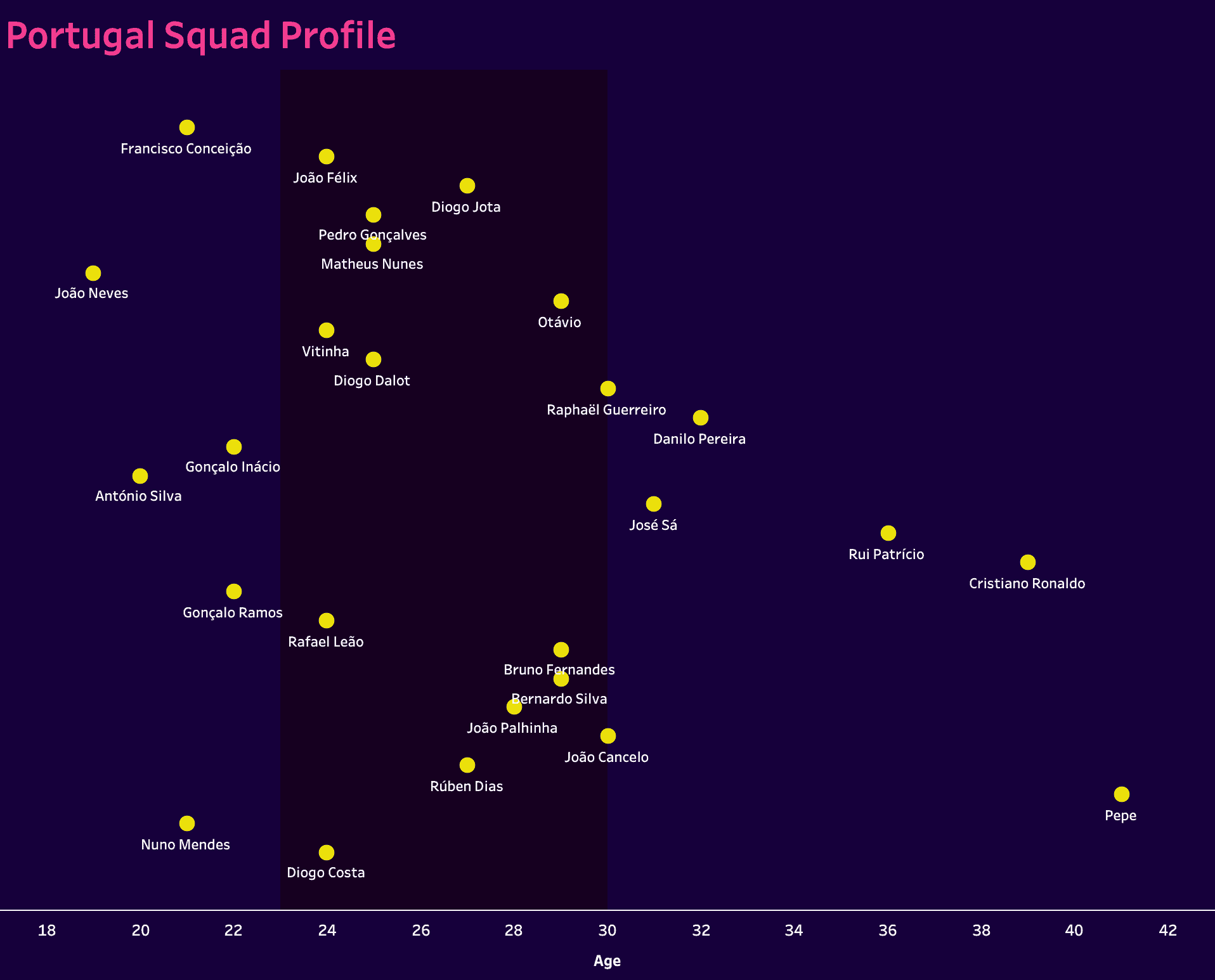
Looking at the squad profile, you get a sense of how immensely talented this group of players is.
There are so many top-end talents that haven’t even received mention at this point.
That squad depth will be key to Portugal’s tournament, allowing Martínez to rotate players and keep the squat’s legs fresh for a deep run.
Attacking phase
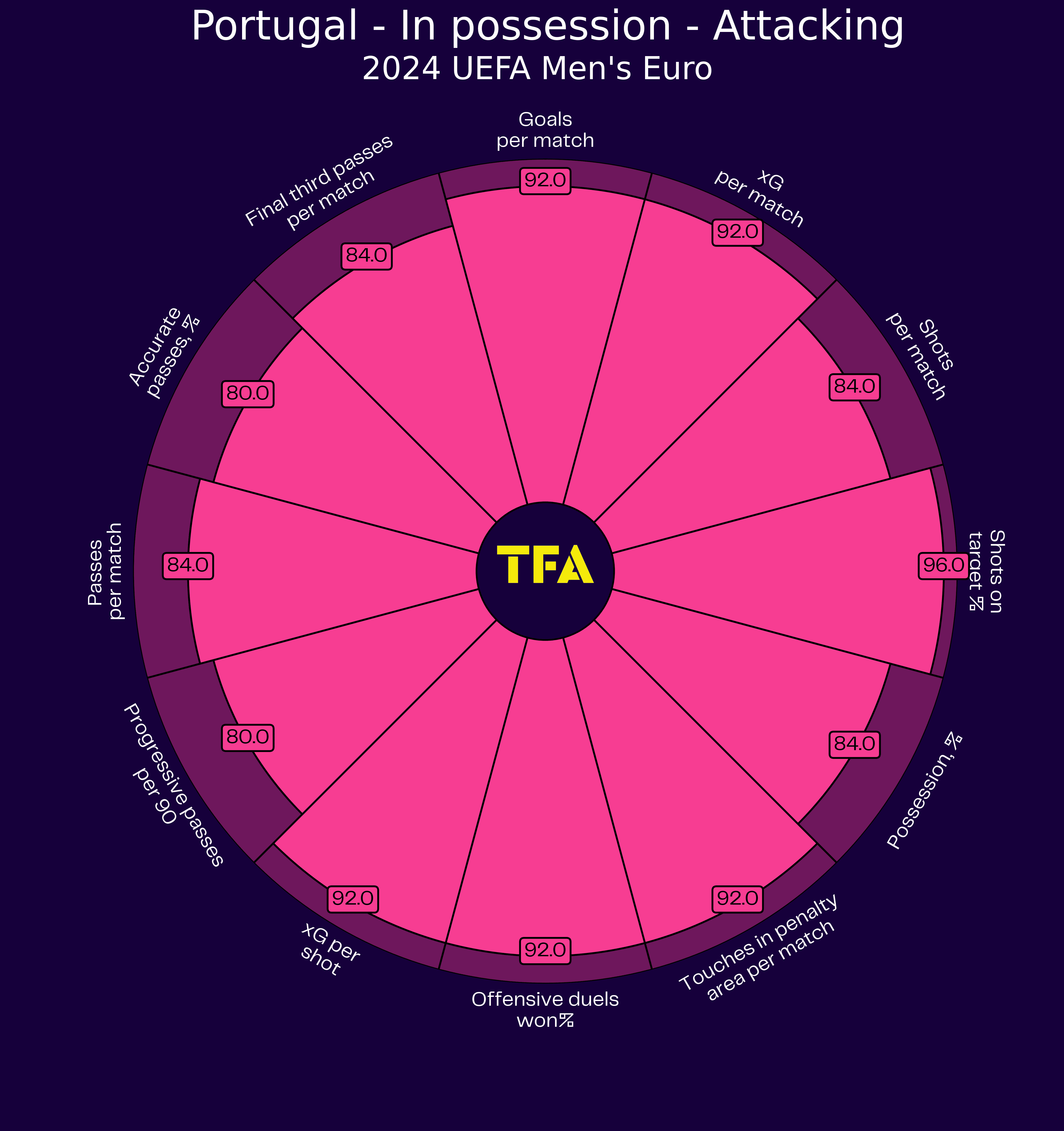
Looking at Portugal’s in-possession radar, which offers an analysis of their past calendar year, it’s clear to see that this is a potent squad with few, if any, weaknesses in possession.
It’s a team that has found an effective approach to its attacking tactics and will be difficult to keep off the scoresheet.
What makes this side’s attacking approach so special?
Let’s start at the back.
We’ve mentioned that the forward line can play a very fluid style.
There is some fluidity during the build-out as well.
Paulina takes that deepest role in midfield and remains a tight connection with his centrebacks.
That allows the two central defenders to dribble into midfield and draw the opposition higher up the pitch.
As they look to engage the next line, the #6 will swap rolls with them.
Danilo is another player we haven’t mentioned at this point.
One of his greatest strengths is his ability to play either the #6 or centreback.
Regardless of which player is on the pitch, these dynamic positional rotations will be in place within Portugal’s build-out tactics.
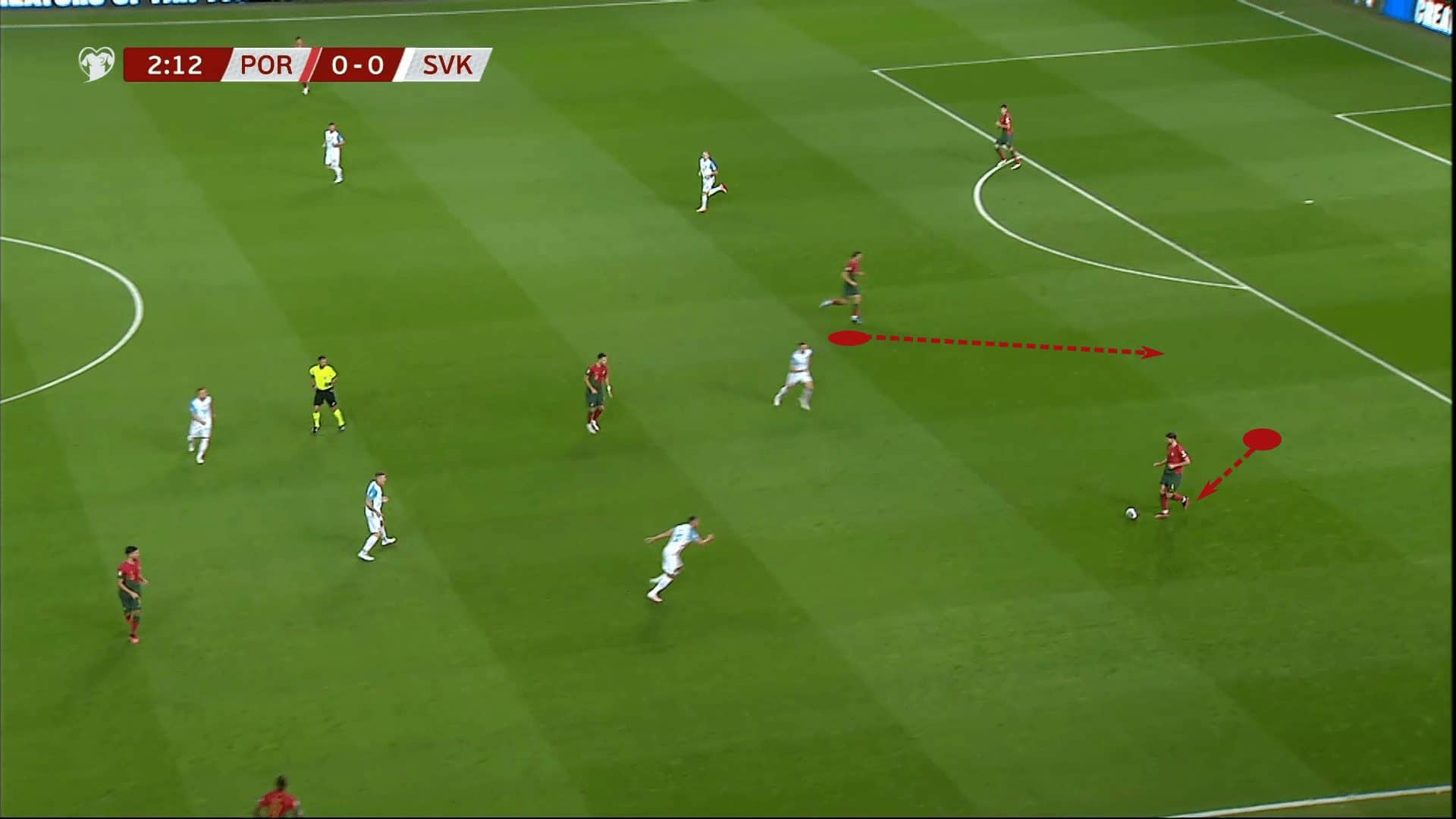
Once Portugal gets into the middle third, they’ll push numbers high up the field.
Once possession is secured, they’ll shift to more direct attacks.
There’s a clear change in tempo from quick, short passes along the back that are designed to pull the opposition forward to attacking a team that has become unbalanced along the vertical axis.
That’s precisely what we have in the image below.
As Bosnia and Herzegovina steps forward, Portugal uses movement along the top line to create space to play into a runner moving behind the backline.
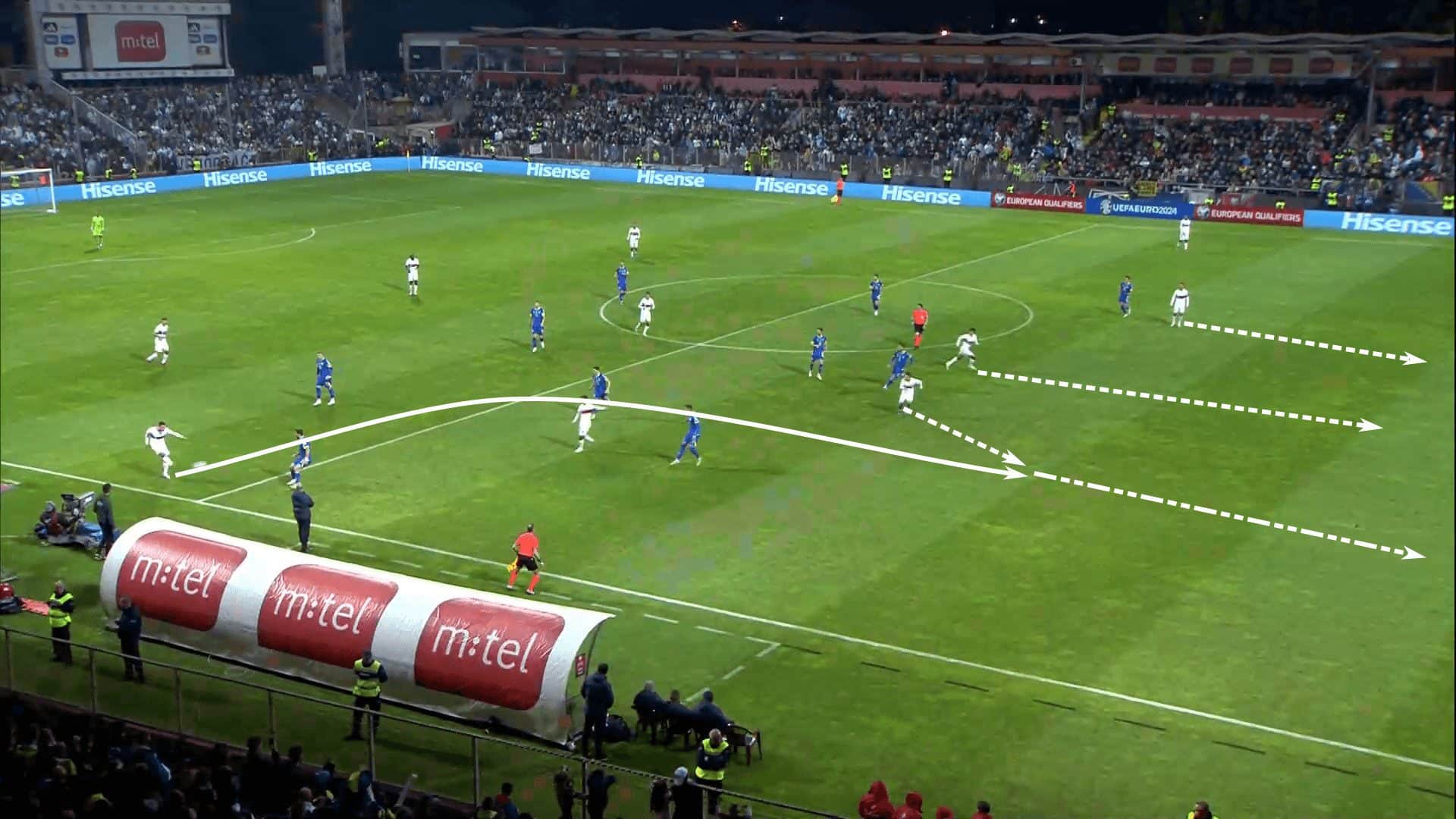
One really interesting point about this Portuguese team is that, while they can play the long diagonals to break the press, there’s also an emphasis on balls played forward within the same channel or just into the neighbouring vertical channel.
That’s a difficult ball to play, but between the two images featuring those more direct passes, it’s clear they have the talent to play an effective, well-weighted, straight pass behind the backline.
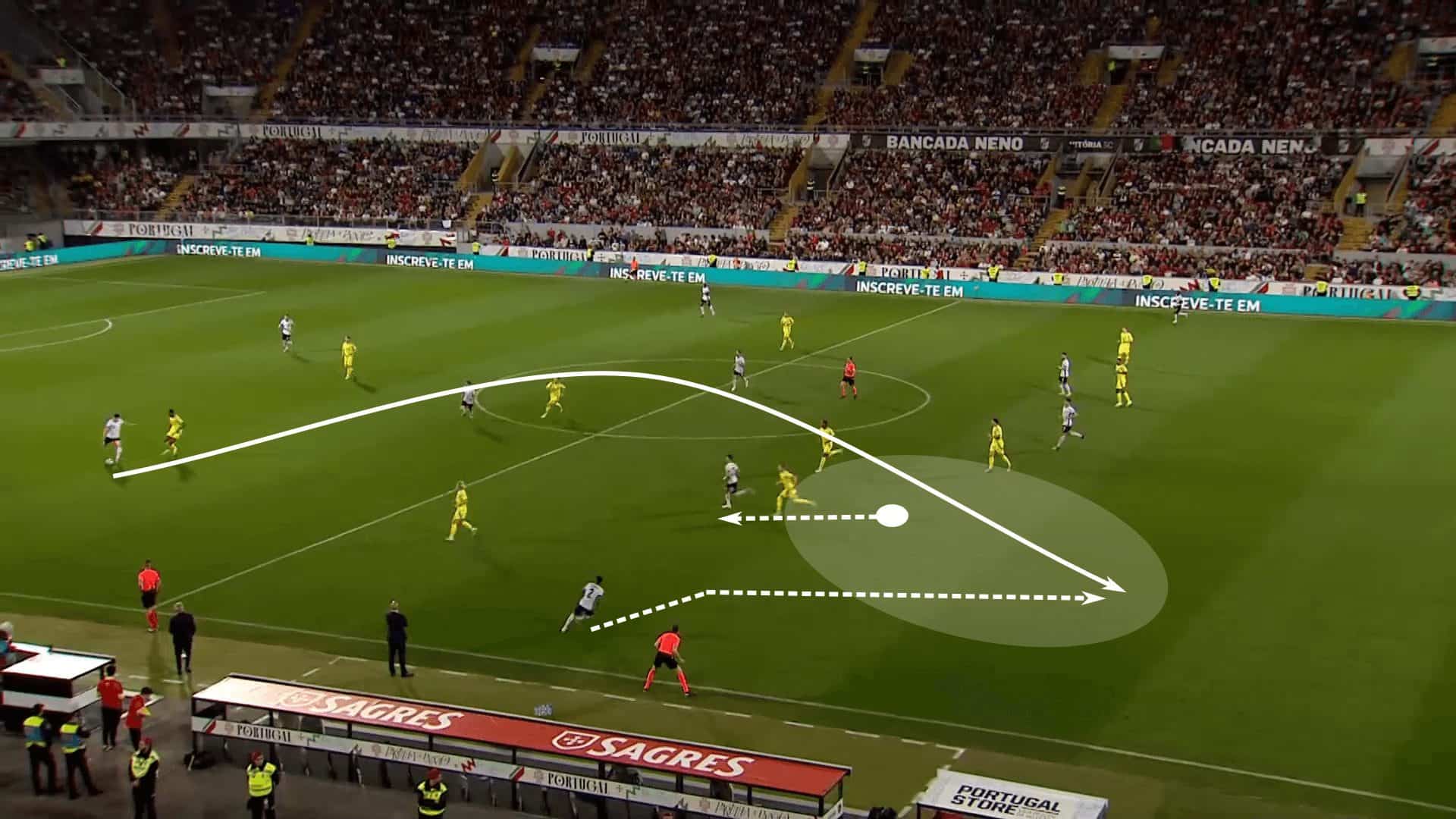
When Portugal does enter the final third and is looking for a crossing situation or that final ball into the box, this is where their versatility takes the spotlight.
When they have lined up with Ronaldo, Ramos and Leão up top, it’s common to see Ronaldo take a more central position while the right-back provides width.
Portugal’s central numbers are exceptional at stretching the backline to create space between the opposition lines, as well as provide anywhere from three to five players in the box to attack the final ball.
In our final image in this attacking tactic section, the lines indicate where Portugal’s forwards are, with Ronaldo playing a nominal right-forward role.
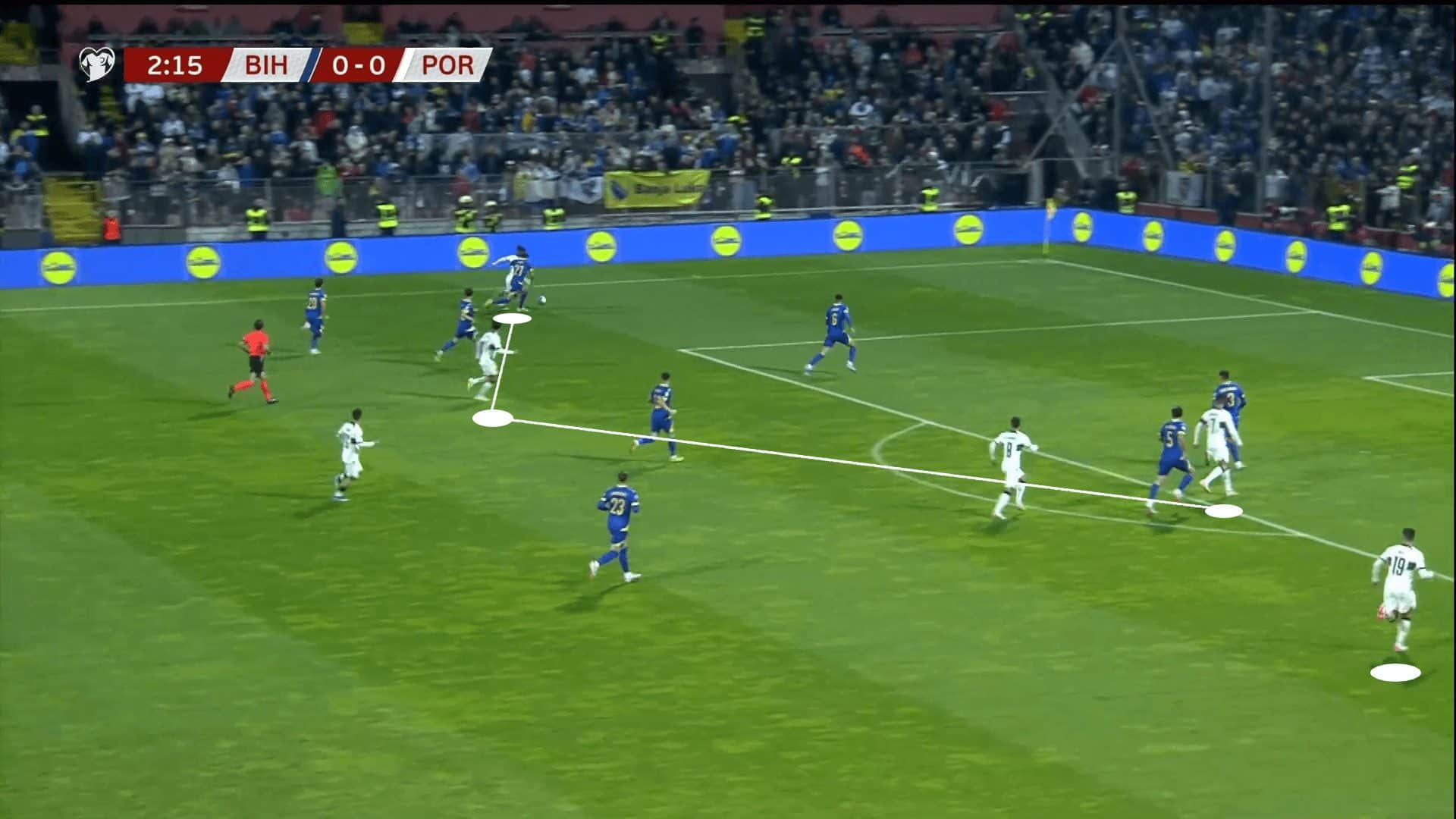
Ultimately, when Portugal enters the final third, they will get numbers high and central to give them the best chance of meeting a ball in the box.
They’ll also layer in the runs, moving off of each other to find gaps in the opposition’s defence.
Given the wide array of playmakers sending that final pass, opponents will be hard-pressed to limit A Seleção’s quality opportunities to goal.
Defensive phase
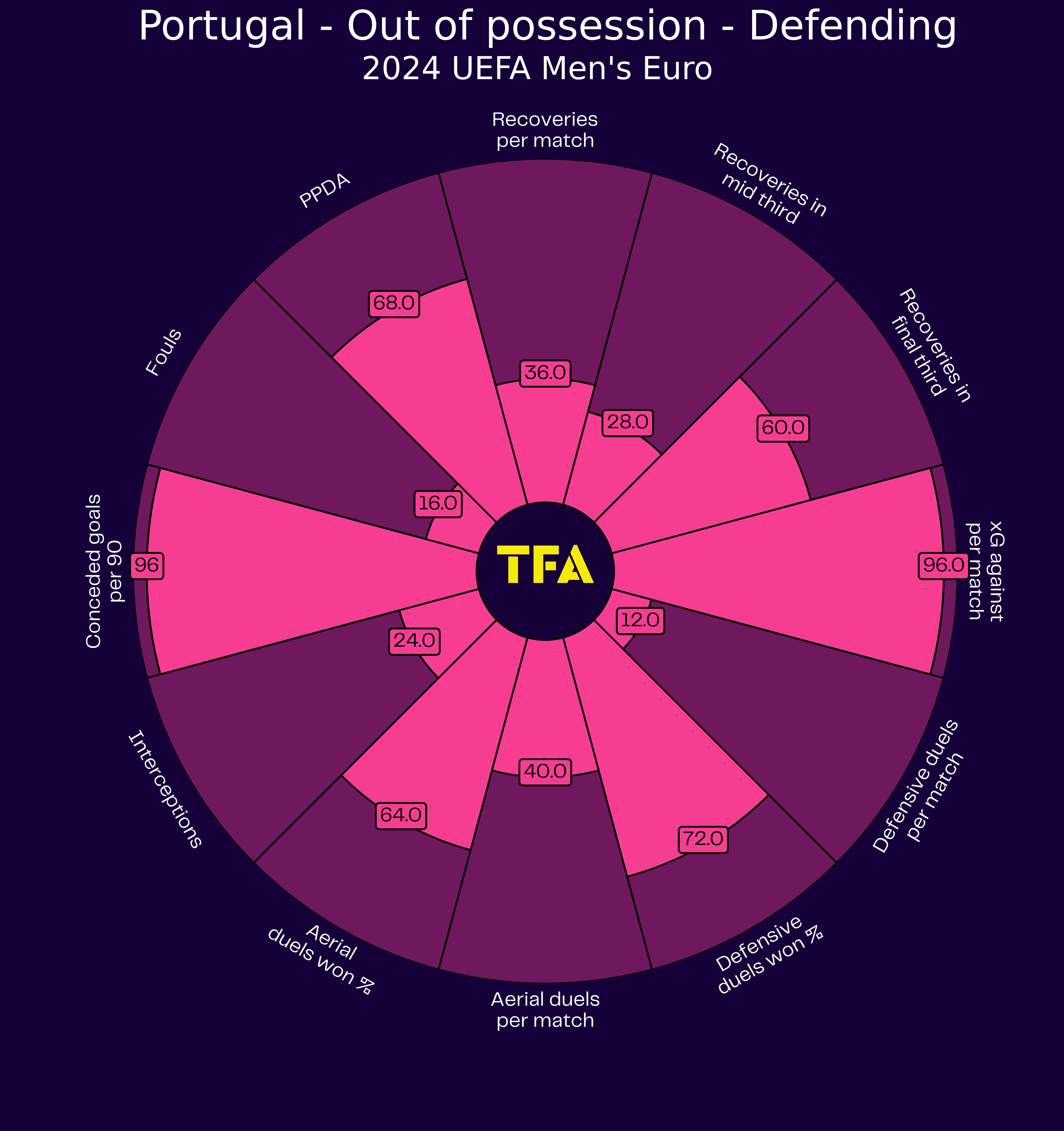
The prolific attack is reasoning enough for optimism and enthusiasm in the Portuguese camp.
Their defensive capabilities are the icing on the cake.
This team will not only be fun to watch in possession, but they’ll be tough for opponents to break down as well.
Researching for this article and generally following Portugal through the qualification campaign, one thing that’s clear is the buy-in Martínez has from the squad.
Even the playmakers and top-end talent up top work hard in transitional moments and buy into the team’s pressing tactics.
To start, a general principle of Portugal’s press is that they want the opponent’s deepest players to take the initiative in the build-out.
They won’t necessarily chase goalkeepers or centrebacks to accelerate the opposition’s attacking tempo.
Instead, they’ll let the deepest players get on the ball, forcing them to engage.
In our first image, we see a man-oriented zone with tight marking on the players nearest the ball.
When the goalkeeper is standing on the ball, if Portugal sees an instance where he has to take an additional touch before playing, at that point, they’ll transition from press to pressure.
There has to be a clear trigger for the Portuguese to move from either a mid-block or 3/4 press into a high press.
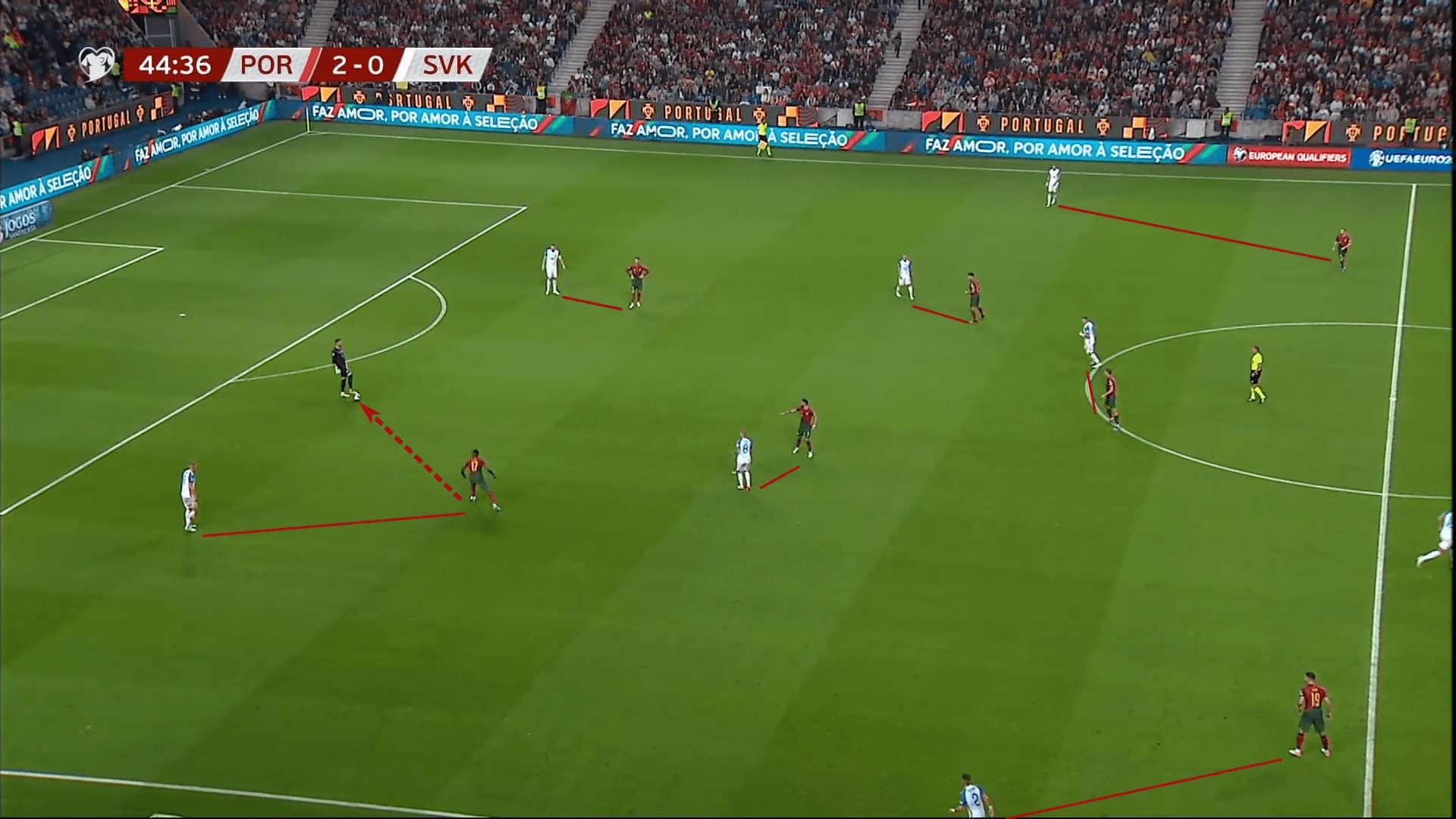
This next sequence gives us a clear view of that transition.
With Bosnia looking to build out on their right, Portugal funnelled them into the wings and used their man-oriented zonal marking to further compress the field.
With no options to play forward, the negative pass all the way back to the keeper was the only way outside of the Portuguese press.
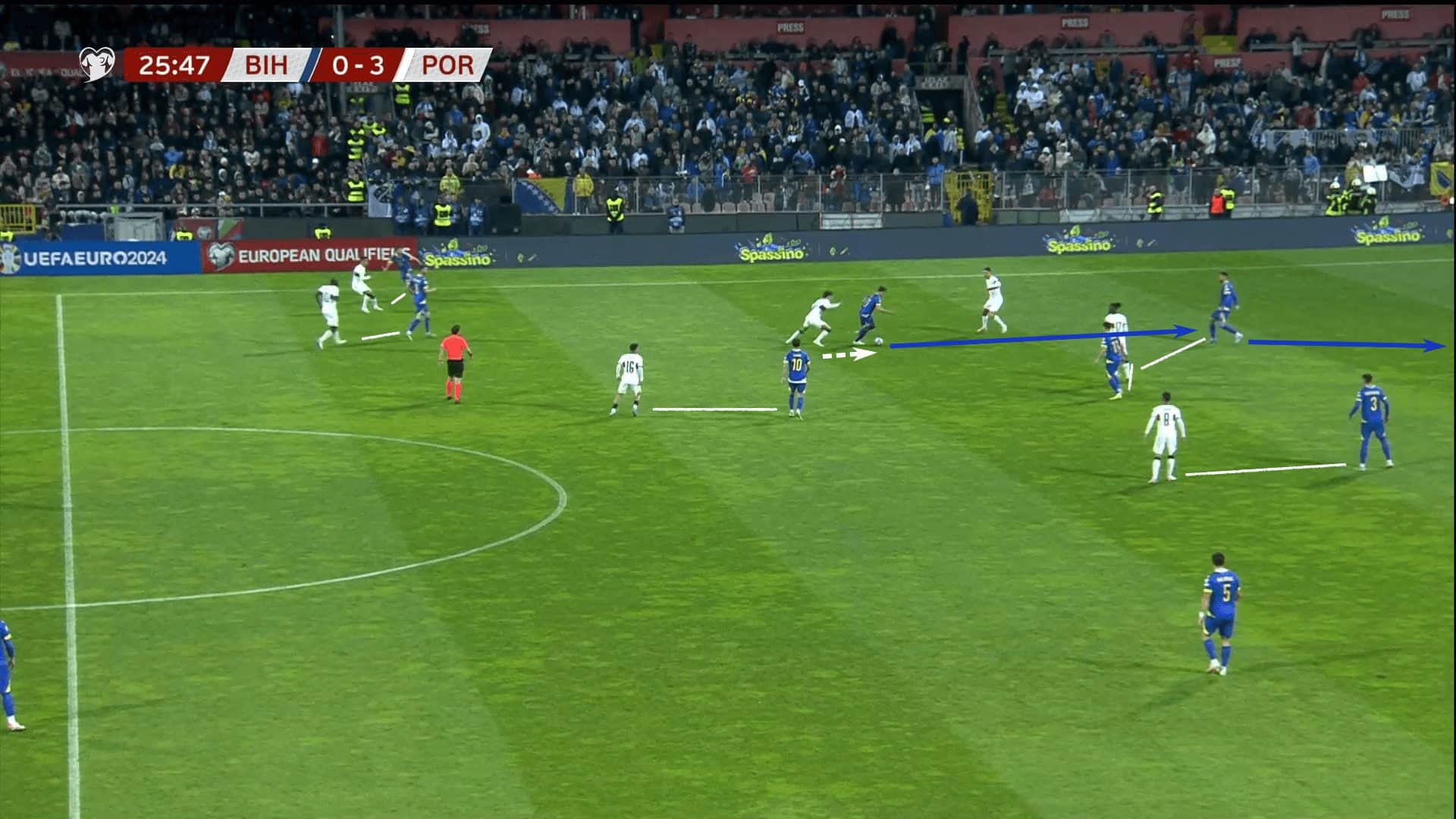
That negative pass was the pressing trigger Portugal was waiting for.
Fernandes arced his run from the right side of Portugal’s defensive shape and forced the keeper to play forward, leading to a Portuguese recovery quickly.
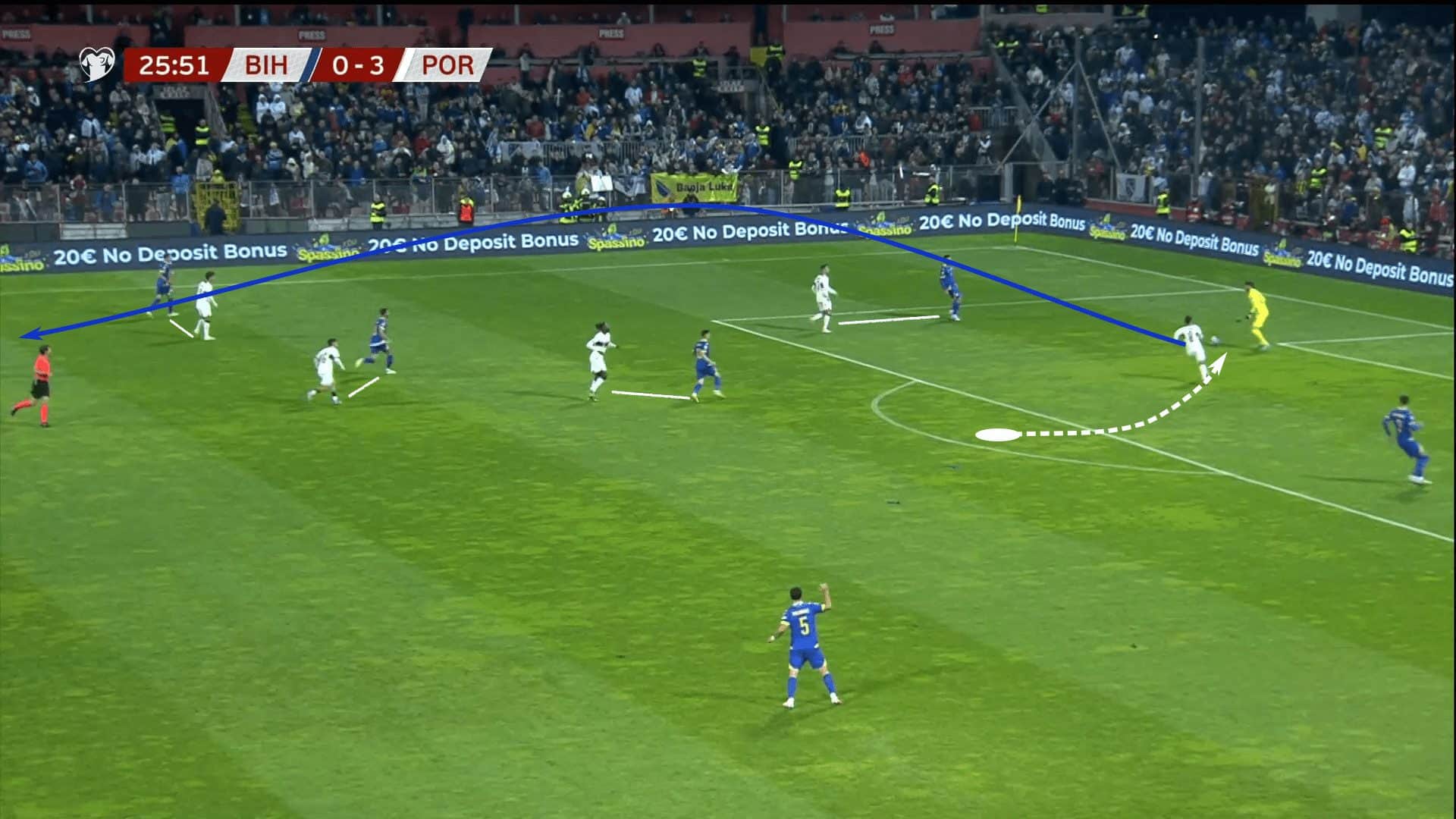
While the defensive tactics will typically look like a mid-block or 3/4 press, a better analysis is to say that Portugal will prioritise numbers behind the ball and adapt the way they engage based on the location of the ball and the identified moments to transition from press to pressure.
Transitions
As good as Portugal is with structured attacks, including their ability to generate artificial transitions, their counterattacking could be one of the highlights of the tournament.
They find the right balance of getting numbers forward, engaging the opposition’s backline, and not overextending themselves, which makes them defensively susceptible.
With all the star power at the top of the formation, there’s an element of trust that the players who get forward can get the job done.
Taking a look at a transitional moment from the critical qualifier in Bosnia, we can see that Portugal’s defending shape left only Ronaldo in front of the ball but clearly connected to the press and took away negative options.
When the pass was misplaced, Leão, who was the left forward in this match, recovered the ball in Portugal’s right half-space and started the counterattack.
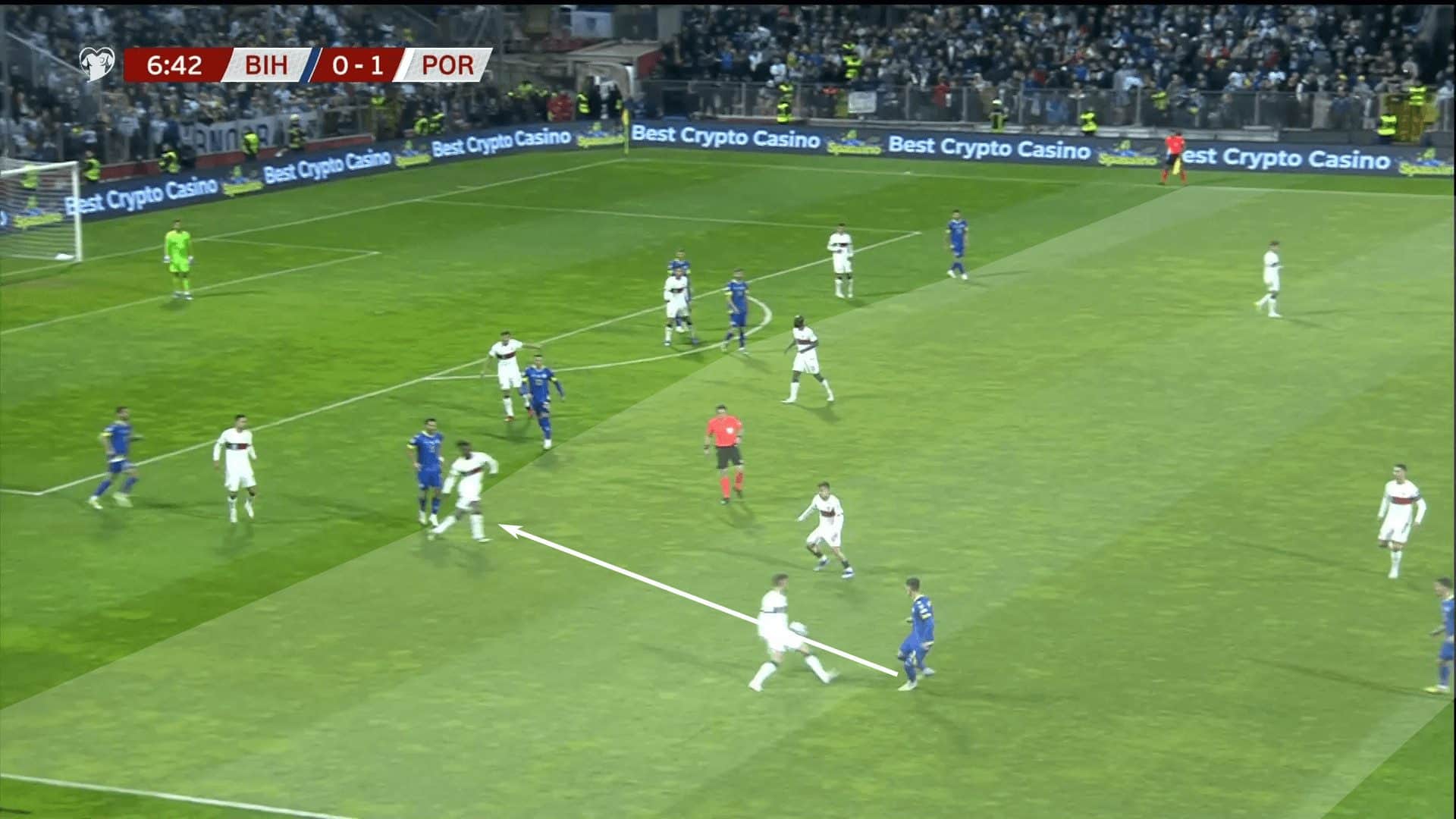
Dribbling forward, he quickly set up a 4v4 in the other direction.
One thing to note about this second image is the amount of space between the four Portuguese attackers and the Bosnian and Herzegovina midfield.
When Portugal counterattacks, watch how much space they create between the opposition’s lines.
While the backline is in a full-fledged retreat, midfielders will lose valuable meters as Portugal races in the other direction.
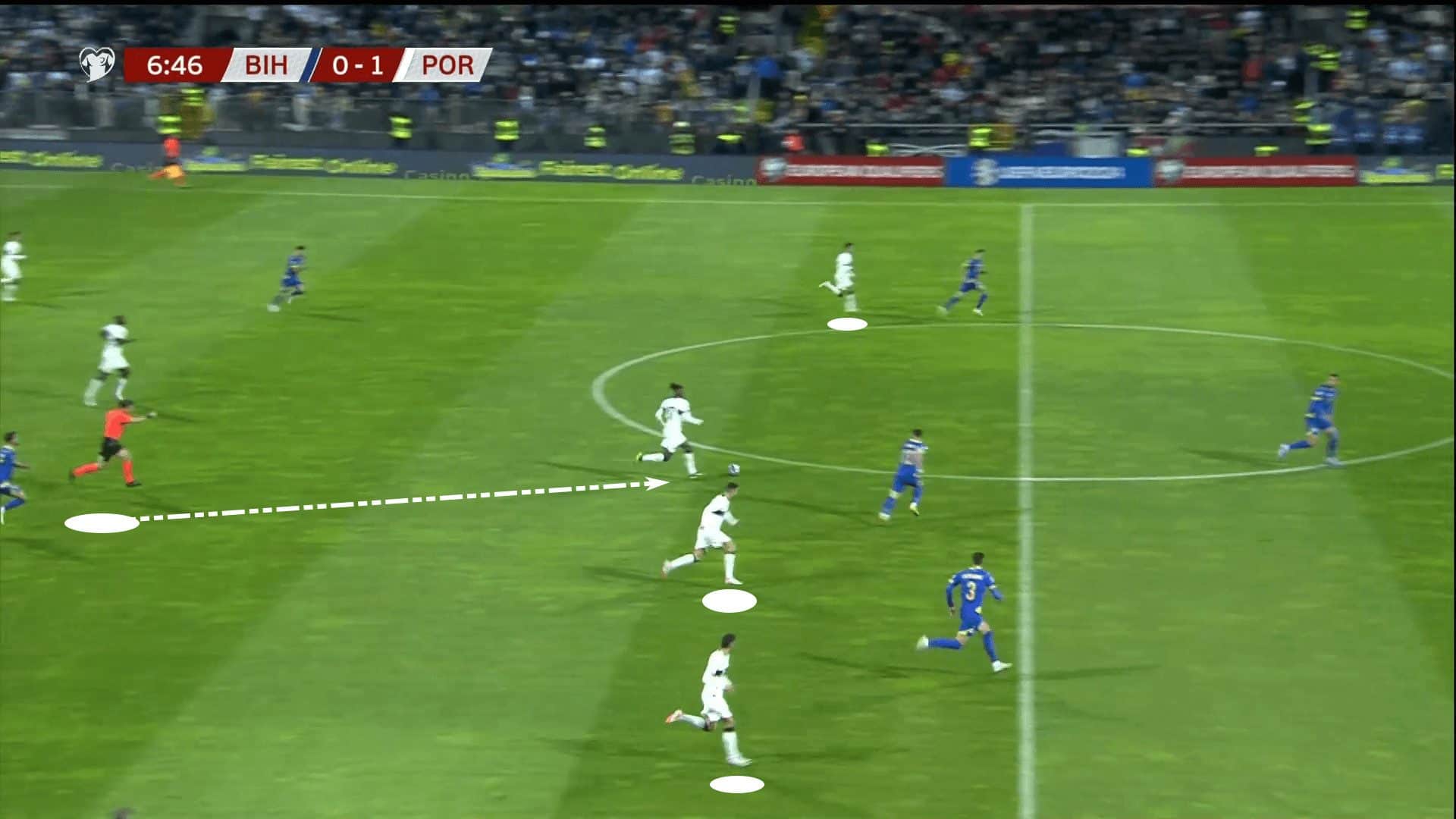
In terms of defensive transitions, Portugal’s rest defence will typically allow them to keep numbers behind the ball and limit the opposition’s success.
With four or five players typically behind the ball at any given moment, even if the first wave of the counterpress is broken, they still have numbers to delay the opposition’s attack, allowing their higher teammates to get behind the ball and pick the right moments to engage.
This Bosnian counterattack is a perfect example.
Though Portugal got numbers near the ball early after losing possession, Bosnia managed to break free and push upfield.
Even as Bosnia pushes up the field, Portugal still maintains a 4v3 advantage along that highest line and has two players recovering to contest the two central players driving the Bosnian attack forward.
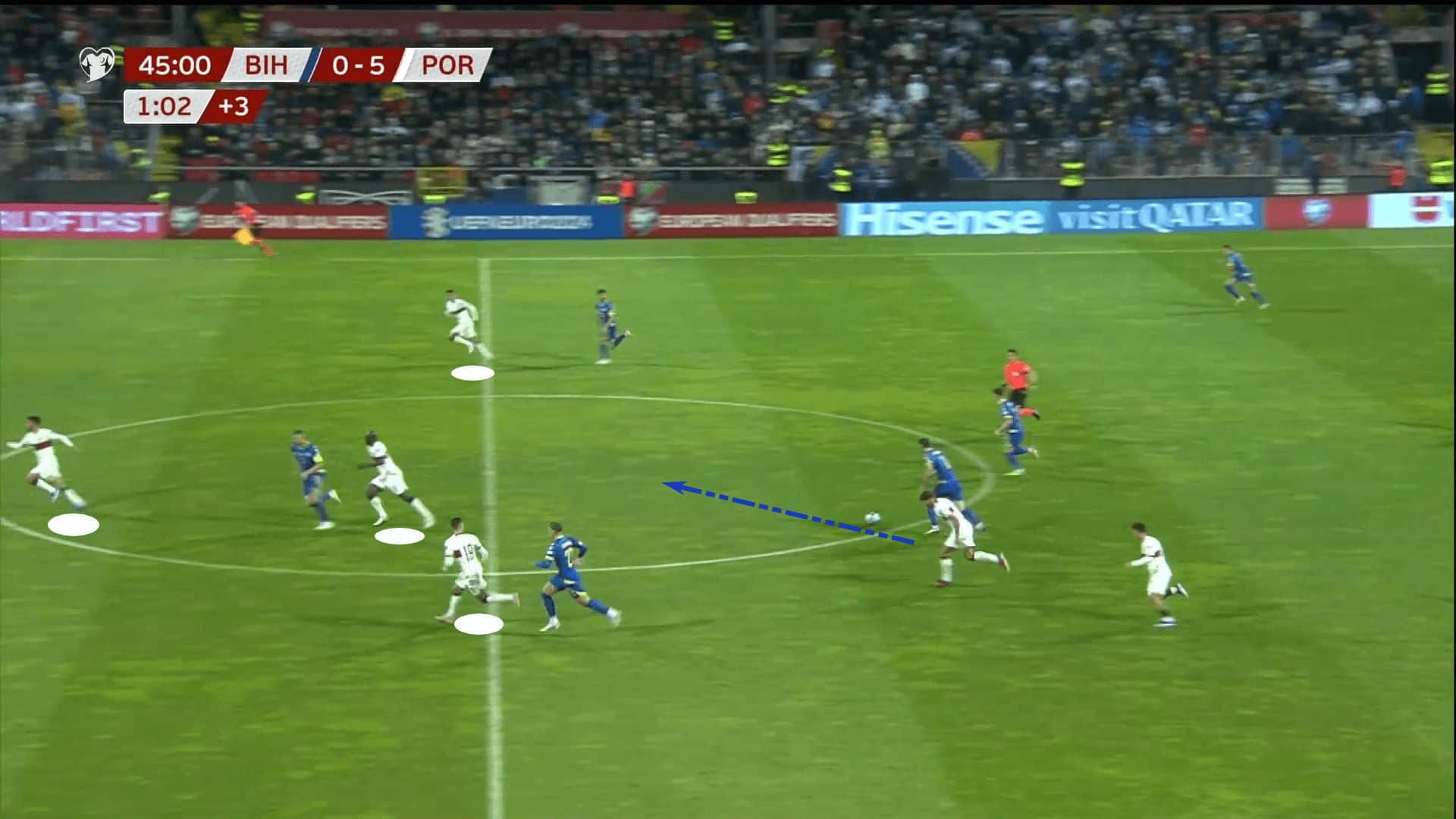
Transitions Will be an area of strength for the Portuguese.
A strong attacking shape will ensure they can limit the opponent’s counterattacking opportunities.
It’s that attacking transition that opponents must be weary of.
As fans, it’s those moments that will get you out of your seats.
Portugal’s pace, power, and collective genius are sure to delight me.
Forwards
Up top, Portugal has a wealth of options.
Cristiano Ronaldo had another stellar qualifying campaign and has routinely featured for Martínez.
He and Leão consistently received the most starts along the forward line.
Bernardo Silva will get his chances on the right, as will Gonzalo Ramos at the #9.
João Félix and Diogo Jota will factor in as well.
Recently fit Pedro Neto beats out Sporting’s Pedro Gonçalves while Porto’s Francisco Conceição gets the nod.
Midfielders
In midfield, Bernardo Silva and Bruno Fernandes will likely be focal points, as well as Palhinha.
Portugal has extraordinary depth in midfield with PSG’s Vitinha, Otávio, Benfica starlet João Neves, and Ruben Neves.
Danilo will likely get a run in midfield as well.
Defenders
Dias and Pepe are the likely starters at centreback along the backline, with Danilo, Antonio Silva and Gonçalo Inácio as the next options.
Outside-back is an interesting position.
Portugal has such extraordinary depth out wide, but look for Nuno Mendes and João Cancelo to feature.
Cancelo can also go to the left, meaning Manchester United’s Diogo Dalot can take his spot on the right.
Bayern Munich‘s Raphaël Guerreiro isn’t fit, meaning Nelson Semedo receives a spot on the roster.
In goal, Costa should see most, if not all, of the minutes.
He’s backed up by Rui Patrício and José Sá.
Key player
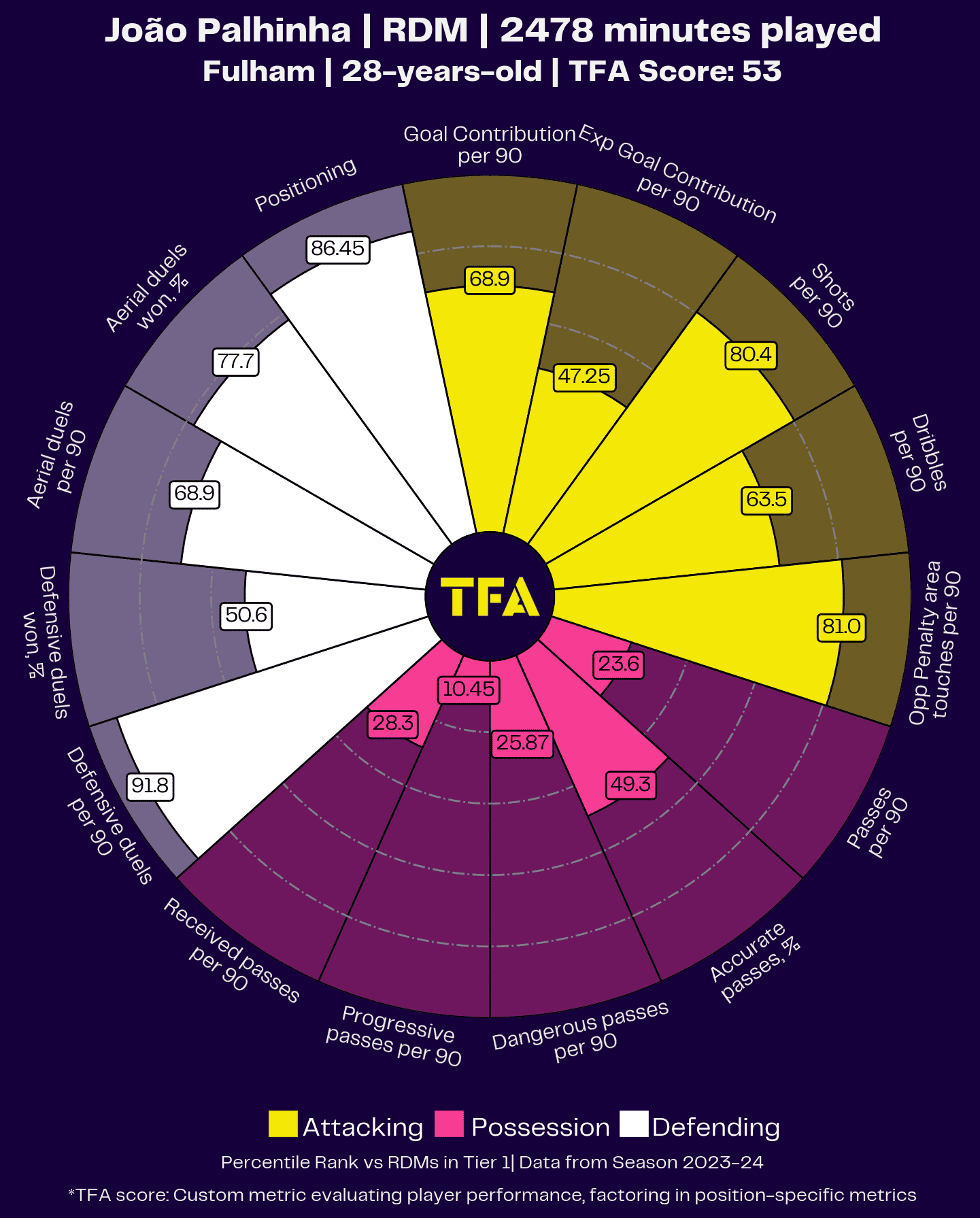
Picking the best player on this Portugal team is a fool’s errand.
The same can be said for the most impactful.
With so much quality and depth, they can beat you in a hundred different ways.
Now, given the fluidity of Portugal’s in-possession tactics, one critical component is the need for defensive solidity.
This is why Palhinha of Fulham is our key player.
Portugal does well to find a balance between attacking and defending, but one of the crucial link players is the man operating at the #6.
With Portugal’s depth, there are a few extraordinary options to fill the role, but the likeliest is the former Sporting player.
His ball-winning in midfield, protection of the backline and set-piece defending will be critical pieces to Portugal’s tournament run.
If they are to advance far into the tournament, they’ll need a strong showing from Palhinha and any other Portuguese midfielders operating in that deeper role.
Tournament prediction
Portugal will feel excellent about their title chances.
The clear favourite in the group, they’ll look to continue their strong qualification campaign with a first-place showing at the group stages.
Though tournament football is unpredictable and the path through the knockout stages can throw obstacles in a team’s path, this Portuguese side should at least do their part to win the group, giving themselves a more favourable match in the Round of 16.
The ceiling is very high for this Portuguese squad.
Between the talent level in the team, the strength of the starting XI and the extraordinary depth on the roster, Martínez has a side that’s begging for a deep run in the tournament.
Portugal will be one of the teams to watch.
They’re one of the most complete teams, as well as one of the most entertaining.
Circle the dates on your calendar.
This team is must-see TV.

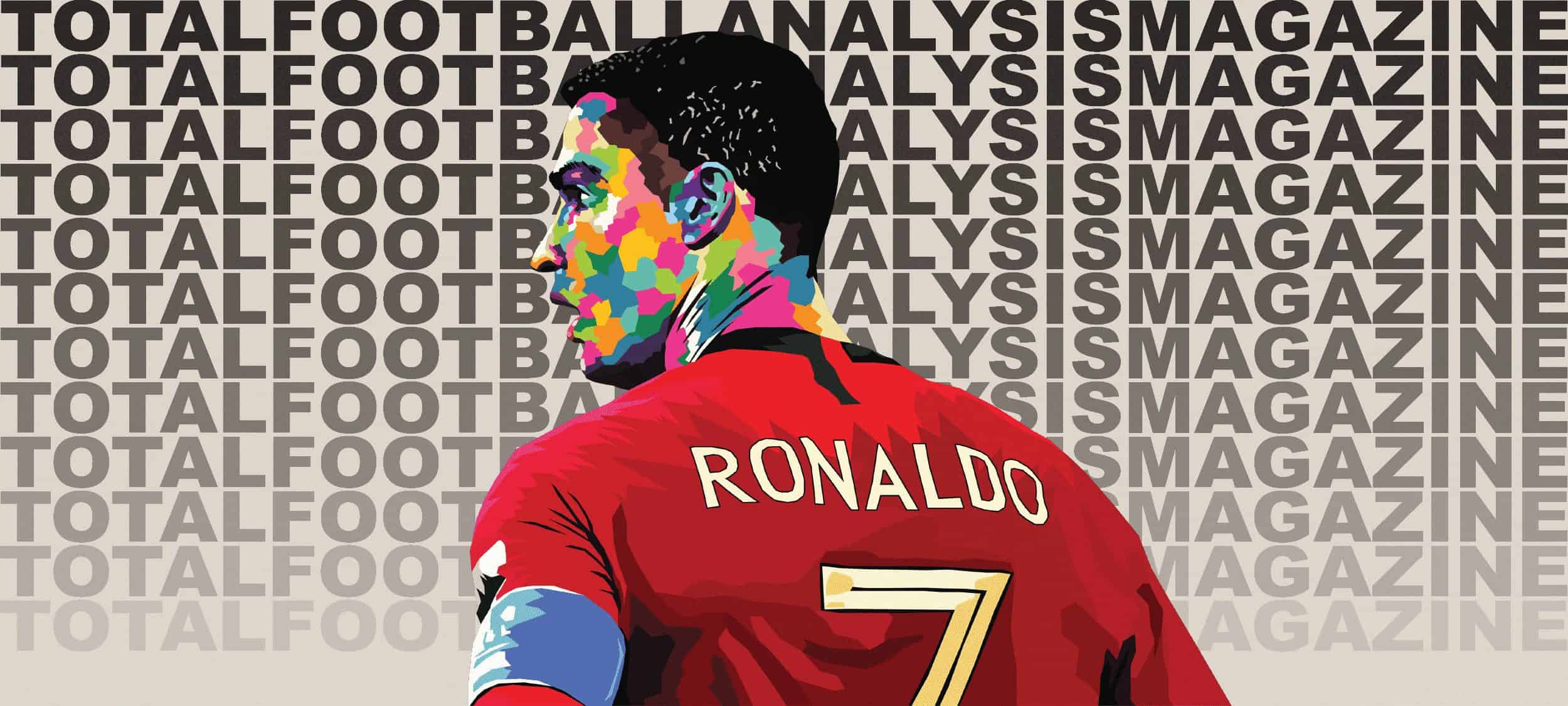



Comments